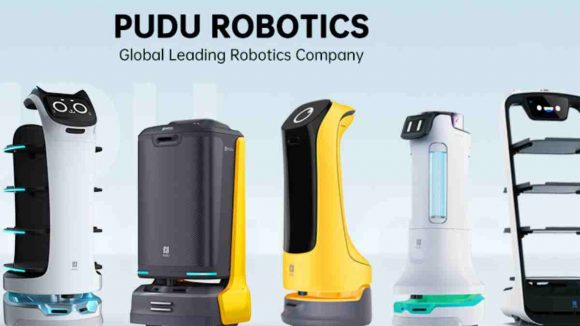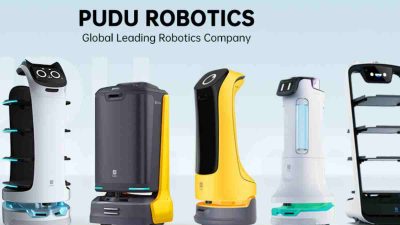Pudu Robotics anticipates a future where more service robots interact with other smart systems and devices, like opening electronic doors, navigating access control systems, and using elevators.
Locate2u News sat down with the Shenzhen-based company. It’s won multiple awards over the seven years since starting in 2016. It partnered with solid brands like Walmart, KFC, Pepsi, Coca-Cola, and Burger King.
In a world completely submerged in digitalization and an avalanche of artificial intelligence initiatives, Pudu Robotics tries to position itself as a frontrunner. Its fleet operates in over 60 countries and regions worldwide.
“In the next few years, we expect technology to play an even more integral role in enhancing customer service. Robots will not just react to customer requests but will also proactively anticipate needs through advanced data analytics and machine learning,” the company tells Locate2u News.
“At Pudu Robotics, we are leveraging the power of the Internet of Things (IoT) to enhance the capabilities of our robots in various service environments. Our robots are now integrated with restaurant management systems such as queue management, POS (Point Of Sale), and Kitchen Display Systems, allowing seamless order-taking and food delivery.”
Robots use advanced sensors, IoT connectivity protocols, and APIs that allow robots to ‘talk’ to other smart devices and systems within the building. This helps to ensure robots are not just “standalone units but part of a cohesive.”
What sets Pudu apart
The most popular and versatile robots in Pudu’s fleet are BellaBot and KettyBot. These two robotic employees take the “repetitive tasks” off the to-do lists. Things like “product promotion, delivery, and in-store navigation.” Its goal is to redefine the customer experience with interactive robots.
How are they setting the bar high for other AI developers? Pudu Robotics tells Locate2u: “Our transformative impact on the retail industry is exemplified by our collaboration with Carrefour Poland. The introduction of BellaBot, named ‘Kerfuś’ locally, led to a substantial increase in in-store foot traffic.”
On a global scale, Pudu robots are being utilized by Walmart, Shell gas stations, All Day Supermarket in the Philippines, and MediaMarkt in various European nations. What makes these AI-powered robots different is that they guide customers about new products.
Robots shaping the future
According to Pudu Robots, two winning ingredients are shaping the future of customer care with robotics. Robots “enhance efficiency by allowing human employees to focus on complex and personalized service,” which reduces customer waiting times.
Secondly, in Pudu’s case, robots also interact with customers. “Our robots can navigate autonomously in various environments, from restaurants and hotels to hospitals, providing food delivery, guiding, and information dissemination services. This ensures consistent service quality.”
Robots can offer companies something that humans will never be able to compete with – working around the clock. This is ideal for businesses where service is required 24/7. Pudu Robotics says this increases productivity and service and leads to a spike in customer satisfaction, as assistance is available anytime.
“Robots are also becoming more interactive and capable of engaging with customers in ways that were previously not possible. With advancements in AI, natural language processing, and machine learning, robots can now understand and respond to a wide range of customer queries, making the interactions more human-like,” Pudu Robotics explains.
How does human-robot interaction work?
Large language models can effectively enhance human-robot interaction, particularly in semantic understanding, explains Pudu Robotics.
“Take, for instance, a robot serving as a shopping guide in a supermarket. Previously, to find a specific brand of electric toothbrushes, customers needed to navigate through ‘personal care,’ then ‘toothbrushes,’ followed by ‘electric toothbrushes,’ and finally, the brand. With significant improvements in voice recognition and semantic understanding, it’s now possible to locate the item directly through a single command.”
Large language models (LLMs) are highly beneficial for advancing end-to-end algorithms in modules such as positioning, navigation, and perception, significantly enhancing the efficiency of their evolution to achieve global optimization.
Pudu says robots and LLM integration are underway, but “manufacturers need to ensure that the generated content aligns with human values and safety standards.” At the same time, it’s also vital to ensure that robots can reliably and responsibly interact with the real world.
This year, these models are expected to be used effectively in robots, tablets, and phones.
Must human workers feel threatened?
Of course, the use of robots is becoming more prevalent across most industries, which makes humans feel threatened by an employee who doesn’t need to sleep, take lunch breaks, or need a salary. But Pudu Robotics sees it as an opportunity for “freeing up employees to provide more personal customer service.” It’s not the intention to wipe out all human labor.
Judging by the labor shortage affecting various sectors in retail, healthcare, and manufacturing, it can lead to several customer problems, like longer wait times. Labor issues impact the service quality, making it extremely difficult to scale operations during peak periods.
The China-based company says there are many great opportunities for businesses using robots.
- It alleviates labor issues by not needing to pay for employee benefits, health insurance, and pensions.
- Robots can operate continuously without fatigue, leading to heightened efficiency and potentially lower operating costs for companies.
- Robots can drastically improve customer service by ensuring high-quality interactions.
- In retail, robots manage inventory, allowing employees to provide more personal customer service.
“It’s crucial to recognize that robots are not here to replace human employees but to complement them. They allow human workers to focus on areas where they excel, like customer engagement, problem-solving, and creativity.”
Pudu Robotics says they prioritize fostering a synergistic environment where humans and robots work together to enhance the overall customer experience.
“Robotics can play an essential role in mitigating these pressures by taking on tasks such as cleaning, delivery, inventory management, and basic customer service. This helps maintain service standards and allows human employees to focus on more intricate, customer-centric responsibilities.”
** To get in touch with Pudu Robotics: anhui.hu@pudutech.com
About the author
Mia is a multi-award-winning journalist. She has more than 14 years of experience in mainstream media. She's covered many historic moments that happened in Africa and internationally. She has a strong focus on human interest stories, to bring her readers and viewers closer to the topics at hand.











